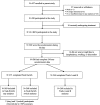Replacing sedentary time with physical activity or sleep: effects on cancer-related cognitive impairment in breast cancer survivors
- PMID: 29940894
- PMCID: PMC6019533
- DOI: 10.1186/s12885-018-4603-3
Replacing sedentary time with physical activity or sleep: effects on cancer-related cognitive impairment in breast cancer survivors
Abstract
Background: Evidence suggests reallocating daily sedentary time to physical activity or sleep confers important health benefits in cancer survivors. Despite emerging research suggesting physical activity as a treatment for cancer-related cognitive impairment (CRCI), little is known about the interactive effects of behaviors across the 24-h period. The present purpose was to examine the cognitive effects of reallocating sedentary time to light-intensity physical activity, moderate-to-vigorous physical activity (MVPA), or sleep in breast cancer survivors.
Methods: Breast cancer survivors (N = 271, Mage = 57.81 ± 9.50 years) completed iPad-based questionnaires and cognitive tasks assessing demographics, health history, executive function, and processing speed (Task-Switch, Trail Making). Participants wore an accelerometer for seven consecutive days to measure their sedentary, physical activity, and sleep behaviors. Single effects (each behavior individually) and partition (controlling for other behaviors) models were used to examine associations among behaviors and cognitive performance. Isotemporal substitution models were used to test the cognitive effects of substituting 30 min of sedentary time with 30 min of light-intensity activity, MVPA, and sleep.
Results: MVPA was associated with faster Task-switch reaction time in the partition models (stay: B = - 35.31, p = 0.02; switch: B = - 48.24, p = 0.004). Replacing 30 min of sedentary time with 30 min of MVPA yielded faster reaction times on Task-Switch stay (B = - 29.37, p = 0.04) and switch (B = - 39.49, p = 0.02) trials. In Trails A single effects models, sedentary behavior was associated with faster completion (B = - 0.97, p = 0.03) and light-intensity activity with slower completion (B = 1.25, p = 0.006). No single effects were observed relative to Trails B completion (all p > 0.05). Only the effect of MVPA was significant in the partition models (Trails A: B = - 3.55, p = 0.03; Trails B: B = - 4.46, p = 0.049). Replacing sedentary time with light-intensity activity was associated with slower Trails A (B = 1.55 p = 0.002) and Trails B (B = 1.69, p = 0.02) completion. Replacing light activity with MVPA yielded faster Trails A (B = - 4.35, p = 0.02) and Trails B (B = - 5.23, p = 0.03) completion.
Conclusions: Findings support previous research suggesting MVPA may be needed to improve cognitive function in breast cancer survivors. Trails findings underscore the need to dissect sedentary contexts to better understand the impact of daily behavioral patterns on CRCI. Additional research investigating the cognitive impacts of behaviors across the 24-h period is warranted.
Trial registration: This study is registered with United States ClinicalTrials.gov ( NCT02523677 ; 8/14/2015).
Conflict of interest statement
Ethics approval and consent to participate
This study was approved by the Institutional Review Board at the University of Illinois at Urbana-Champaign. All participants digitally signed the iPad-based consent form prior to enrollment in the study.
Consent for publication
This section is not applicable to the present study.
Competing interests
The authors declare that they have no competing interests.
Publisher’s Note
Springer Nature remains neutral with regard to jurisdictional claims in published maps and institutional affiliations.
Figures
Similar articles
-
Replacing sedentary time with sleep, light, or moderate-to-vigorous physical activity: effects on self-regulation and executive functioning.J Behav Med. 2017 Apr;40(2):332-342. doi: 10.1007/s10865-016-9788-9. Epub 2016 Sep 1. J Behav Med. 2017. PMID: 27586134 Free PMC article. Clinical Trial.
-
Replacing sedentary time with physical activity and sleep: associations with quality of life in kidney cancer survivors.Cancer Causes Control. 2020 Jul;31(7):669-681. doi: 10.1007/s10552-020-01308-x. Epub 2020 May 11. Cancer Causes Control. 2020. PMID: 32394230
-
Effects of reallocating sedentary time with physical activity on quality of life indicators in breast cancer survivors.Psychooncology. 2019 Jul;28(7):1430-1437. doi: 10.1002/pon.5091. Epub 2019 May 8. Psychooncology. 2019. PMID: 30980431 Free PMC article.
-
Light-intensity and moderate-to-vigorous intensity physical activity among older adult breast cancer survivors with obesity: A narrative review.Cancer Med. 2022 Dec;11(23):4602-4611. doi: 10.1002/cam4.4841. Epub 2022 May 26. Cancer Med. 2022. PMID: 35620805 Free PMC article. Review.
-
Effects of exercise on cancer-related cognitive impairment in breast cancer survivors: a scoping review.Breast Cancer. 2023 Nov;30(6):885-909. doi: 10.1007/s12282-023-01484-z. Epub 2023 Jul 22. Breast Cancer. 2023. PMID: 37480454 Free PMC article.
Cited by
-
The Use of Wearable Devices in Oncology Patients: A Systematic Review.Oncologist. 2024 Apr 4;29(4):e419-e430. doi: 10.1093/oncolo/oyad305. Oncologist. 2024. PMID: 37971410 Free PMC article.
-
Lessons learned from an observational study of patients with breast cancer: adaptions for remote implementation.Support Care Cancer. 2025 Mar 11;33(4):266. doi: 10.1007/s00520-025-09323-x. Support Care Cancer. 2025. PMID: 40067570 Free PMC article.
-
Substituting bouts of sedentary behavior with physical activity: adopting positive lifestyle choices in people with a history of cancer.Cancer Causes Control. 2022 Aug;33(8):1083-1094. doi: 10.1007/s10552-022-01592-9. Epub 2022 Jun 14. Cancer Causes Control. 2022. PMID: 35699799 Free PMC article.
-
The MASCC COG-IMPACT: An unmet needs assessment for cancer-related cognitive impairment impact developed by the Multinational Association of Supportive Care in Cancer.Support Care Cancer. 2025 Jan 24;33(2):120. doi: 10.1007/s00520-025-09149-7. Support Care Cancer. 2025. PMID: 39853439 Free PMC article.
-
Predictors of Patient Engagement With an Interprofessional Lifestyle Medicine Program.Am J Lifestyle Med. 2023 Dec 23:15598276231222877. doi: 10.1177/15598276231222877. Online ahead of print. Am J Lifestyle Med. 2023. PMID: 39464233 Free PMC article.
References
-
- Ehlers D, Trinh L, McAuley E. The intersection of cancer and aging: implications for physical activity and cardiorespiratory fitness effects on cognition. Expert Rev Qual Life Cancer Care. 2016;1:347–350. doi: 10.1080/23809000.2016.1241661. - DOI
MeSH terms
Associated data
Grants and funding
LinkOut - more resources
Full Text Sources
Other Literature Sources
Medical


